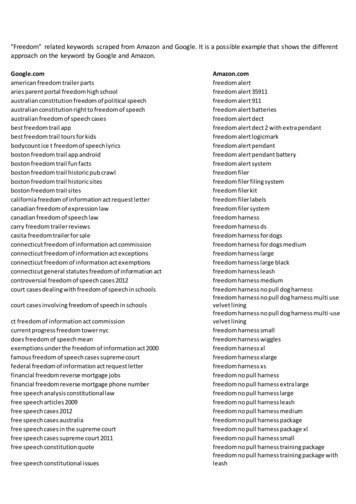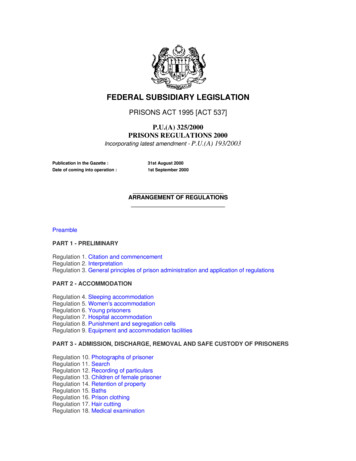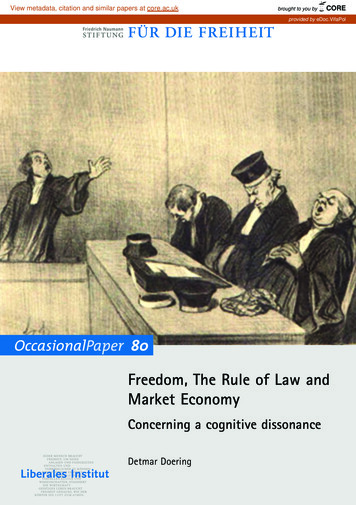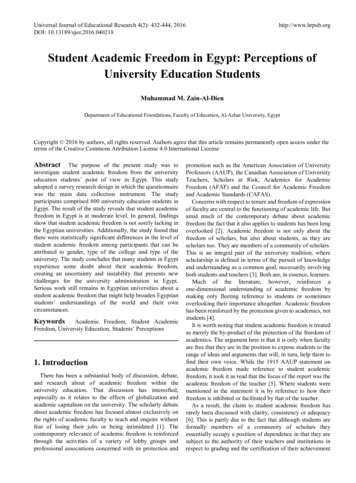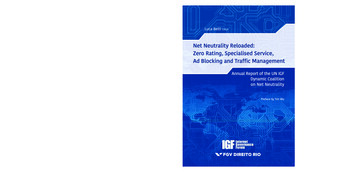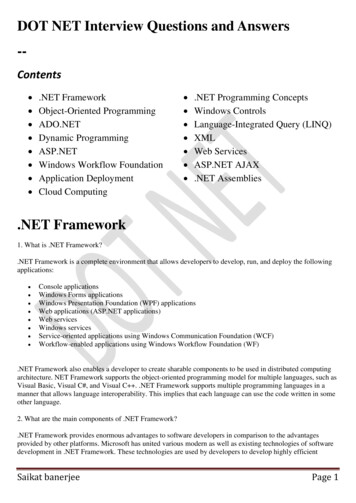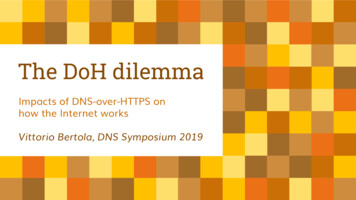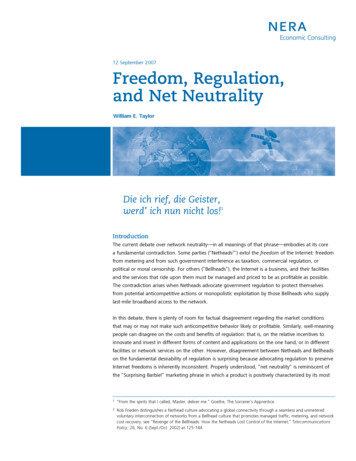
Transcription
12 September 2007Freedom, Regulation,and Net NeutralityWilliam E. TaylorDie ich rief, die Geister,werd’ ich nun nicht los!1IntroductionThe current debate over network neutrality—in all meanings of that phrase—embodies at its corea fundamental contradiction. Some parties (“Netheads2”) extol the freedom of the Internet: freedomfrom metering and from such government interference as taxation, commercial regulation, orpolitical or moral censorship. For others (“Bellheads”), the Internet is a business, and their facilitiesand the services that ride upon them must be managed and priced to be as profitable as possible.The contradiction arises when Netheads advocate government regulation to protect themselvesfrom potential anticompetitive actions or monopolistic exploitation by those Bellheads who supplylast-mile broadband access to the network.In this debate, there is plenty of room for factual disagreement regarding the market conditionsthat may or may not make such anticompetitive behavior likely or profitable. Similarly, well-meaningpeople can disagree on the costs and benefits of regulation: that is, on the relative incentives toinnovate and invest in different forms of content and applications on the one hand, or in differentfacilities or network services on the other. However, disagreement between Netheads and Bellheadson the fundamental desirability of regulation is surprising because advocating regulation to preserveInternet freedoms is inherently inconsistent. Properly understood, “net neutrality” is reminiscent ofthe “Surprising Barbie!” marketing phrase in which a product is positively characterized by its most1“From the spirits that I called, Master, deliver me.” Goethe, The Sorcerer’s Apprentice.2Rob Frieden distinguishes a Nethead culture advocating a global connectivity through a seamless and unmeteredvoluntary interconnection of networks from a Bellhead culture that promotes managed traffic, metering, and networkcost recovery: see “Revenge of the Bellheads: How the Netheads Lost Control of the Internet,” TelecommunicationsPolicy, 26, No. 6 (Sept./Oct. 2002) at 125-144.
negative attribute. Whatever else it does, a doll never surprises. The Internet today is not and cannotever be “neutral” across a vast array of applications, and advocating regulation to preserve neutralityin this context risks the outcome lamented by the sorcerer’s apprentice.The Markets, the Players, and the ProblemInternet markets are complicated and identifying the players and their roles will help fix ideas. Thinkof “application providers” as firms at one end of a network supplying content, e.g. web pages, voicecommunications, search engines, massive multi-player games, etc. Some “content” also facilitatesthe sale of other products and services, e.g., Landsend.com and Amazon.com. “Customers” areend-users at another end of the network, who value and purchase content (and sometimes productsand services) from application providers. Customers, or at least their eyeballs, also representservices sold in the form of advertising by some application providers (e.g., Yahoo!) in this classictwo-sided marketplace.3 “Access providers” are the telecommunications carriers that supply lastmile, dedicated access to the Internet to application providers at one end and customers at another.“Carriers” include access providers at the ends of the network, as well as the suppliers of backbonenetwork facilities that interconnect with one another ultimately to connect applications providersand customers.This paper examines the economics of one aspect of net neutrality, so-called “access tiering.” Thequestion here is whether the current Internet standard of “best effort” carriage of data packetsshould be modified to permit voluntary prioritization of traffic: i.e. to allow carriers to providedifferent qualities of service in some dimensions for a price to different applications, differentapplication providers, or different customers. Differential quality of service (QoS) arises in a packetswitched network when the network experiences congestion. At every switching point in a network,switches (called “routers”) receive traffic in the form of packets, examine the destinations of thepackets, and attempt to send each packet down its proper route. When more packets arrive thancan be sent out, routers respond by using alternative routes, by queuing packets for transmissionand ultimately, if their buffers are full, by dropping packets. All of these responses can degradethe QoS experienced by the customer.4 Today, and from its inception, the Internet generally treatsall forms of traffic indiscriminately with respect to the routing, queuing, or dropping of packets,ignoring the nature of the service or the identities of the application providers, the access providers,and the customers. Thus: packets that correspond to the download of a webpage are accorded the same treatment aspackets comprising a VoIP conversation despite the fact that the resulting delay and “jitter” havevastly different effects on the customers’ experiences for these applications; packets corresponding to applications initiated by an AT&T DSL customer are delayed or droppedas frequently for AT&T applications as for Vonage, Google, or Yahoo applications initiated bythat customer; and packets corresponding to some real-time medical procedure between a doctor and a distanthospital are subject to the same delay and jitter as packets carrying Yahoo instant messagesbetween bored high school students in math class.2www.nera.com3Think of customers as honeybees, websites as flowers, and pollination as advertising revenue.4Albeit in different ways for different services. Increased average delay may be unnoticeable for web-browsing butannoying for downloading large files. Increased maximum delay may degrade performance for VoIP conversations orstreaming audio or video applications.
That all traffic is treated equally in this sense is probably the origin of the notion that the Internet is“neutral.” However, as these examples show, neutrality with respect to packets does not translateinto neutrality with respect to applications. It is here that the net neutrality debate has teeth andwhere economics has the most to add to the discussion.Opponents of access tiering argue that permitting access providers to charge application providersfor higher QoS would degrade the performance of other applications, reduce innovation andinvestment in content applications, and allow carriers to leverage their alleged bottlenecks in accessinto anticompetitive advantages in the various markets for applications.On the other hand, proponents of voluntary access tiering respond that: a market for priority mightchange the current distribution of the effects of congestion across applications, but that changewould make customers vastly better off; rather than reducing the incentive to innovate and investin content, access tiering would make it possible to develop applications more highly-valued bycustomers that are currently prohibitively expensive to implement due to congestion from lowervalued traffic; and the limited or non-existent ability and incentive of carriers that are verticallyintegrated into applications to profitably discriminate against their competitors’ applications areinsufficient to warrant ex ante regulation and should be controlled—as they are elsewhere in theeconomy—by the stringent application of antitrust or competition law.Degraded PerformanceProperly construed, access tiering has no effect unless network facilities are congested.Unfortunately, the tragedy of the commons ensures that, over time, the demands of applicationswill expand to fill the capacity available. In the long run, bandwidth, reliability, and low latencyservice will be rationed by some mechanism. Some advocates of net neutrality legislation insist thatprice not be used as the rationing mechanism, at least in part because such an allocation mightdegrade the quality of their favorite applications. For example,The current legislation, backed by companies such as AT&T, Verizon and Comcast, wouldallow the firms to create different tiers of online service. They would be able to sell accessto the express lane to deep-pocketed corporations and relegate everyone else to the digitalequivalent of a winding dirt road.5Instead, packets would be routed without regard for cost or for the customer’s willingness to payfor additional QoS and irrespective of the application or the identity of the customer, the applicationprovider, or the carrier(s).When facilities are congested, some traffic must inevitably be delayed or degraded. Changing theassignment of priority—from the current first-in first-out priority—to something else could degradethe current quality of some applications relative to others when facilities are congested.But using any mechanism to assign priority other than one that reflects cost and consumers’willingness to pay for priority can impose massive welfare losses on society.63www.nera.com5Lawrence Lessig and Robert W. McChesney, “No Tolls on The Internet,” Washington Post, 8 June 2006; page A23.6For example, the welfare-maximizing rule would price the different services at differential markups over the differentincremental costs, where the markups were inversely proportional to the price elasticity of demand.
In a simple example, Litan and Singer estimate the consumer surplus from one QoS-needyapplication—online massive multiplayer gaming7—at between 700 million and 1.5 billion peryear in 2009, surplus that would be lost or reduced if net neutrality regulation were effective inequalizing priority.8 Add to that figure consumer surpluses from other high-bandwidth, low latencyservices such as delivery of IP high-definition video.9 That these applications (and others) would bepriced out of the market in an unmanaged, net-neutral network is clear from some estimates ofRichard Clarke. According to Clarke, the monthly cost to provide capacity for current subscribers inan unmanaged network is about 47 per subscriber. To add sufficient capacity to provide twostandard-definition video channels would triple that cost. To add two high-definition videochannels would increase the cost by a factor of 10.10 While cost estimates are uncertain, it is evidentthat the simple expedient of allowing backbone capacity to increase over time in an unmanagednetwork would render many high-bandwidth services unmarketable at a massive sacrifice ofeconomic welfare.Network pricing that accounts for costs and customers’ willingness-to-pay generally increaseseconomic welfare relative to uniform pricing, particularly where costs are largely fixed, uniformmarginal cost pricing does not recover the total cost of the network, and differential pricing wouldexpand total network demand. With a single level of quality stemming from best-effort switching,under congestion, customers would be willing to pay more than the average price for QoS-needyapplications but are prevented from doing so by regulation. At the same time, QoS-irrelevantapplications are supplied at a higher level of quality than customers would be willing to pay for.Both errors entail welfare losses.An implied but unstated concern of some proponents of net neutrality regulation is thatconsumers’ demand for video services, if unchecked, would absorb all available capacity and thusdegrade the Internet experience of other users.11 While I might share Professor Lessig’s apparenttaste for video services, I know of no better mechanism to allocate scarce capacity than marketprices. If providing high-definition streaming video is costly and customers’ demand for the serviceis insatiable, then the response time for applications I prefer may suffer, but economic welfare as awhole may be enhanced.4www.nera.com7Ask your children.8R.E. Litan and H.J. Singer, “Slouching Towards Mediocrity: Unintended Consequences of Net Neutrality Regulation,”Journal on Telecommunications and High Technology Law, 2007, downloaded from http://papers.ssrn.com/sol3/papers.cfm?abstract id 942043.9And if the inefficient undersupply of these particular services leaves you unmoved, consider why such frivolous usesof scarce capacity are not charged the opportunity costs they impose on the socially more valuable uses you favor.10Clarke, Richard N, “Costs of Neutral/Unmanaged IP Networks” (May 2006) at 20. Available at SSRN:http://ssrn.com/abstract 903433 .11For example: “The incentives in a world of access-tiering would be to auction to the highest bidders the qualityof service necessary to support video service, and leave to the rest insufficient bandwidth to compete.” Testimonyof Lawrence Lessig Before the Senate Committee On Commerce, Science and Transportation Hearing on NetworkNeutrality, 7 February 2006.
Innovation and InvestmentThe Internet has arguably been responsible for the greatest transformation of industry andcommerce since the Industrial Revolution. It has spawned new and innovative services andgenerated billions of dollars of investment, both in applications and by carriers in new equipmentand facilities. Some proponents of network neutrality regulation observe the so-called “end-to-end”design of the network and infer that this particular architecture—intelligence and control at thenetwork edges and transparency at the center—is optimal for innovation. For example,One consequence of this design is that early network providers couldn’t easily control theapplication innovation that happened upon their networks. That in turn meant that innovationfor these network (sic) could come from many who had no real connection to the owners ofthe physical network itself This diversity of innovators is no accident. By minimizing the control by the network itself, the“end-to-end” design maximizes the range of competitors who can innovate for the network.Rather than concentrating the right to innovate in a few network owners, the right toinnovate is open to anyone, anywhere.12While admiration for the innovation and investment associated with the Internet is understandable,the implication that the end-to-end architecture is a necessary cause of that growth is not. Withtransparent best-effort switching, a wide variety of largely QoS-independent applications weredevised and marketed successfully as the capacity of the Internet and penetration of broadbandaccess increased. In a different architecture—say, one that permitted voluntary priority pricing—a different mix of applications would emerge, but there is no theory or evidence to suggest thatthe amount of innovation (somehow quantified) or, particularly, the value of those innovations toconsumers would have been less. Why would the ability of an application provider to choose amonga range of QoS standards for the network reduce its incentive to invest and innovate? Indeed, ifpriority prices reflected the costs of priority as well as consumers’ valuations of the applications thatdepend on priority, one would expect more valuable innovation in a market-determined networkarchitecture rather than less.Anticompetitive DiscriminationOf course, the assumption that priority prices would be set in effectively competitive markets is notone that network neutrality proponents would accept. Rather, Netheads point to concentration inthe broadband access markets and infer that access and backbone facility providers would have theincentive and ability to exercise market power and to leverage it from access into the provision ofapplications. The economics of this claim are dubious.First, the carriers’ ability to exercise or leverage market power from access is constrained bythe presence of multiple broadband access providers, including telephone, cable, and wirelesscarriers. An access provider that degraded competitors’ applications would be handicapped in thecompetition in the access market.125www.nera.comTestimony of Lawrence Lessig Before the Senate Committee On Commerce, Science and Transportation Hearing on“Network Neutrality,” 7 February 2006.
Second, the incentive to use a putative access bottleneck to derive a competitive advantage in anapplications market is also questionable. Basic economics shows that—with some exceptions—monopoly profit (e.g., in access) can only be earned once in a vertically-integrated firm, and thatadditional profit cannot—in general—be earned by subsidizing competition in a downstreamapplications market from an upstream access monopoly.13Third, despite the above, if priority pricing is thought to increase the likelihood of anticompetitivepricing (or other behavior) on the part of access providers, the efficient solution is the rigorousapplication, ex post, of the antitrust or competition laws. Generally speaking, ex ante economicregulation only makes sense in cases of natural monopoly, where an efficient industry structureprecludes entry and inefficient monopoly pricing would be the natural consequence. In marketsopened to competition, ex ante regulation is too blunt an instrument to distinguish betweenvigorous competition and anticompetitive acts. As a result, a reasonable answer to Netheads whofear anticompetitive leveraging of an access monopoly into markets for applications is to enforcethe antitrust laws, rather than restricting ex ante the pricing and provisioning of services for whichcustomers are willing to pay.14Unintended Consequences of the Regulation of Access TieringEx ante economic regulation, particularly in markets opened to competition, necessarilyimposes costs on society. These costs include the inherent market, technology, and investmentdistortions that stem unavoidably from economic regulation of any service—retail or wholesale.These distortions are particularly acute in current telecommunications markets where retailmarkets are subject to effective competition, where regulatory authority differs across competingplatforms, and where the markets are characterized by rapid technological change and competingplatforms or technologies subject to lock-in or path dependence.15 Such regulation does not merelytransfer welfare among suppliers but inevitably distorts technical choices which can have largeand irreversible welfare effects on consumers, reducing economic efficiency and productivity bydistorting the competitive market outcome, and driving the market to an inefficient platformor technology.In particular, detecting anticompetitive discrimination in priority would be difficult. Consider a carrierwhose network exhibits higher jitter than other networks so that the quality of VoIP applications forits customers is degraded.6www.nera.com13See, e.g., Robert H. Bork, The Antitrust Paradox: A Policy at War With Itself at 372-75 (2d ed. 1993) or RichardPosner, Antitrust Law: An Economic Perspective 171-74 (1976). The recognized exceptions to this basic theoryinclude avoiding regulation in the upstream market, the presence of variable proportions in the downstream market,and an enhanced ability to price discriminate in the upstream market. See D.W. Carlton and J.M Perloff, ModernIndustrial Organization (Fourth edition) Boston: Addison Wesley, (2005), Chapter 12.14In fact, each of the few examples of anticompetitive conduct by access providers cited by net neutrality proponentswere quickly identified and corrected by the relevant enforcement agency.15For example, consider last-mile broadband access service, which can be provided by wireline, power line, orwireless carriers.
The most challenging possibility, for a policy standpoint, is that [the carrier] didn’t takeany obvious steps to cause the problem but is happy that it exists, and is subtly managingits network in a way that fosters jitter. Network management is complicated, and manymanagement decisions could impact jitter one way or the other. A network provider whowants to cause high jitter can do so, and might have pretextual excuses for all of the stepsthat it takes. Can regulators distinguish this kind of stratagem from the case of fair andjustified engineering decisions that happen to cause a little temporary jitter?16Futile and counterproductive attempts to regulate the details of service quality are familiar fromthe worst days of airline regulation, including prescribing the maximum amount of leg-room,requiring that meals be limited to sandwiches, and establishing uniform additional prices for in-flightentertainment. While these examples appear silly, their consequences are not. Service quality andprice are two sides of the same coin and, together with competition, such regulation reversesthe competitive process, causing costs to move towards a regulated price rather than the otherway around.17In airlines, quality regulation gave rise to the sumptuous three-course sandwich. Intelecommunications, if any lesson can be learned from the growth and diversity of the Internet, itis that networks and the applications that ride on them adapt extremely rapidly and unpredictablyto changes in their environments. In the Internet setting, if some sorcerer’s apprentice invoked agovernment agency to regulate ex ante the terms on which application providers, carriers, andcustomers were permitted to exchange vast amounts of traffic in real time, the consequenceswould be unimaginable.7www.nera.com16E.W. Felton, “Nuts and Bolts of Network Neutrality,” August 2006 .17See A.E. Kahn, The Economics of Regulation, Vol II Boston: The MIT Press (1988) at 209-220.
About NERANERA Economic Consulting is an international firm of economists whounderstand how markets work. We provide economic analysis and advice tocorporations, governments, law firms, regulatory agencies, trade associations,and international agencies. Our global team of more than 600 professionalsoperates in over 20 offices across North and South America, Europe, andAsia Pacific.NERA provides practical economic advice related to highly complex business andlegal issues arising from competition, regulation, public policy, strategy, finance,and litigation. Our more than 45 years of experience creating strategies, studies,reports, expert testimony, and policy recommendations reflects our specializationin industrial and financial economics. Because of our commitment to deliverunbiased findings, we are widely recognized for our independence. Our clientscome to us expecting integrity and the unvarnished truth.NERA Economic Consulting (www.nera.com), founded in 1961 as NationalEconomic Research Associates, is a unit of the Oliver Wyman Group,an MMC company.ContactFor further information contact:William E. TaylorSenior Vice President and Global Communications Practice ChairBoston, MA 1 617 621 2615william.taylor@nera.com
4 www.nera.com In a simple example, Litan and Singer estimate the consumer surplus from one QoS-needy application—online massive multiplayer gaming7—at between 700 million and 1.5 billion per year in 2009, surplus that would be lost or reduced if net neutrality regulation were effective in
